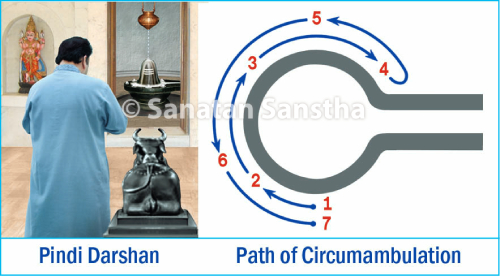Jyotirlingas are the place of worship of Deity Shiva that function at the materialised level

There are 12 Jyotirlingas which are the major places of worship of Deity Shiva in India. These materialised in a radiant form. Jyotirlingas and Swayambhu Shivalingas are under the surface of the Earth. Since these Shivalingas have more of nirguntattva (Non-materialised Principle) when compared with the other Shivalingas, they constantly emit more of nirgun Chaitanya and sattvikata. This helps in continuously purifying the environment on the Earth. Since these waves are constantly emitted towards the Patal (Hell region), they incessantly combat the negative energies there. Hence, the Earth is continuously protected from the attacks of powerful negative energies from the Patal.
Before darshan of the Shiva Pindi have darshan of Nandi

Nandi occupies an important position in Deity Shiva’s family. Nandi in a Shiva temple is Deity Shiva’s vehicle. Before darshan (Viewing) of Deity Shiva and Shiva’s Pindi, have darshan of Nandi. This will help in increasing sattvikata (Spiritual purity) and enhancing the ability to tolerate the powerful waves emitting from Deity Shiva. Do not stand or sit between the Shiva Pindi and Nandi; instead, stand on one side of the line joining Nandi and the Shiva Pindi and then have darshan of the Pindi.
1. Unique attributes of Nandi
A. Sage Sayanacharya derived the word ‘Vrushabha’ from the word ‘vrush’, which means ‘one who showers’. The other meaning of the word is – ‘one with enormous reproductive strength’.
Hence, Nandi (Vrushabha) is believed to be a symbol of developed masculinity.
B. Just as Sage Manu is the first exponent of the Dharmashastras and Bruhaspati that of Arthashastra (Economics), Nandi is the exponent of Kamashastra.
2. Implied meaning of Nandi’s Idol
A. The two fore legs of Nandi denote Truth and Penance. The two hind legs denote Mercy and Donation.
B. Nandi stands on one leg, with the other three bent at the knees. This signifies that in Kaliyug (Era of strife), Dharma (Righteousness) exists only 1/4th than what it really is.
Worshipping the Pindi in a Shiva temple
Generally, worshippers in the temple should not sit directly in front of the flow emitting from the Shalunka (Base of the Linga) while worshipping the Pindi, because, Shakti waves are emitting from the flow in a way that they come directly onto the body of the worshipper; this can be distressing.
Hence, while worshipping the Shiva Pindi, sit elsewhere close to it (See points 1 to 7 in the picture above). The Shiva Pindi is bathed with cold water, milk or Panchamrut (A mixture of milk, curds, honey, sugar and pure ghee).
(Ref.: Sanatan’s Text – ‘Spiritual interpretation of aspects related to Deity Shiva’)
Due to the Jyotirlingas, the Earth is continuously protected from attacks of powerful negative energies from the Patal !

 British Prime Minister’s Office apologises to Hindus
British Prime Minister’s Office apologises to Hindus First Diwali celebrated after the construction of Shriram Mandir in Ayodhya
First Diwali celebrated after the construction of Shriram Mandir in Ayodhya Radiant thoughts of Sachchidananda Parabrahman (Dr) Jayant Athavale
Radiant thoughts of Sachchidananda Parabrahman (Dr) Jayant Athavale Mahanirvan Utsav (24th November 2024) of Saint Bhaktaraj Maharaj
Mahanirvan Utsav (24th November 2024) of Saint Bhaktaraj Maharaj Conspiracy to ban fire crackers on Diwali, but no one talks of slaughter on Eid : Pt. Dhirendra Krishna Shastri
Conspiracy to ban fire crackers on Diwali, but no one talks of slaughter on Eid : Pt. Dhirendra Krishna Shastri Commonwealth countries ask for reparations for slavery from Britain; demand rejected
Commonwealth countries ask for reparations for slavery from Britain; demand rejected